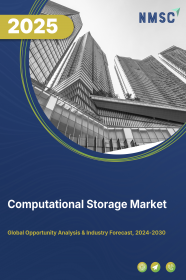
Computational Storage Market by Type (Fixed Computational Storage Services (FCSS) and Programmable Computational Storage Services (PCSS)), by Application (Data Centers, Smart Security Cameras, Bandwidth-constrained Devices, and Others), and by End User (BFSI, Consumer Goods, Media & Entertainment, Automotive & Transportation, Military & Aerospace, Telecommunication, Energy & Power, Healthcare, Agriculture, Retail, and Others) – Global Opportunity Analysis and Industry Forecast 2024-2030
US Tariff Impact on Computational Storage Market
Trump Tariffs Are Reshaping Global Business
Market Definition
The Computational Storage Market size was valued at USD 6.50 billion in 2023 updated and is predicted to reach USD 17.82 billion by 2030 with a CAGR of 15.5% from 2024-2030.
Computational storage involves integrating data storage and processing capabilities within a single storage device, enabling localized data processing. This approach minimizes data transfer overhead on the central processing unit (CPU) and enhances system performance by processing data directly within the storage device. By merging storage and computing functionalities, computational storage optimizes data processing at the storage location, eliminating the need to transfer data to a separate processing unit. Technologies like solid-state drives (SSDs) with embedded processors, memory-based storage devices, and storage-class memory systems reduce latency and bandwidth constraints associated with conventional storage, boosting performance and energy efficiency for data-intensive applications.
Market Dynamics and Trends
The growing demand for data volume and processing needs across various sectors, such as BFSI, Media & Entertainment, and others is fueling the computational storage market. As it helps to keep pace with the processing demands of massive datasets. As per the International Data Corporation (IDC), the global data volume will reach 175 zettabytes by 2025. Of this, an estimated 90 zettabytes will originate solely from IoT devices.
Moreover, rising technological innovations such as cloud computing, IoT, AI, and edge computing drives the need for advanced computational storage solutions capable of managing the growing volume and intricacy of data produced by these technologies.
This demand underscores the critical role of computational storage in optimizing data processing efficiency and performance in the era of expanding digital ecosystems. According to the IDC, the global expenditure on the Internet of Things (IoT) is projected to exceed USD 1 trillion by the year 2026.
In addition, the evolution of consumer behavior towards digital services, e-commerce, and streaming media is boosting demand for computational storage solutions, highlighting their importance in meeting modern consumers' needs for efficient data management. According to the combined estimate by Shopify SkyQuest, and GroupM, the e-commerce market size is expected to reach USD 58.74 billion by 2028, with the growing CAGR of 26.5%.
However, the high initial costs associated with computational storage solutions deter organizations from investing, especially for smaller businesses or those with limited budgets. Thus, it is the major restraining factors in the computational storage market.
On the contrary, the introduction of non-volatile memory express (NVMe) based storage devices offer high-speed data transfer and low latency is expected to create ample opportunities in the growth of the computational storage market in the coming years.
In 2024, NVM Express introduced the computational storage feature, standardizing storage management functions for cloud, enterprise, and IoT sectors. This vendor-neutral framework connects applications to NVMe computational storage devices, improving performance and reducing total cost of ownership by enabling computation directly on storage devices.
Market Segmentations and Scope of the Study
The computational storage market share is segmented on the basis of type, application, and end user. On the basis of type, the market is divided into fixed and programmable. On the basis of application, the market is segmented into data centers, smart security cameras, bandwidth-constrained devices, and others. On the basis of end user, the market is classified into BFSI, consumer goods, media & entertainment, automotive & transportation, military & aerospace, industrial, telecommunication, energy & power, healthcare, agriculture, retail, and others. Regional breakdown and analysis of each of the aforesaid segments include regions comprising of North America, Europe, Asia-Pacific, and RoW.
Geographical Analysis
North America holds the predominant share of the computational storage market and is expected to continue its dominance during the forecast period. This is attributed to factors such as the presence of huge healthcare industry and the need to store large amount of patient’s data in electronic health records (EHRs) for faster data processing, improved patient’s data security, and reduced data transfer times is driving the growth of the computational storage market.
According to the Center for Medicare and Medicaid Services, the healthcare industry in the U.S. reached 4.3 trillion in 2021, which is an increase from USD 4.1 trillion in 2020, increasing the requirement of computational storage solutions to manage the large amount of patient data generated by the industry. Moreover, the presence of key players such as IBM Corporation, Nvidia, and Microsoft Corporation plays an important role in the development of the computational storage market in this region.
For instance, in October 2022, IBM Corporation collaborated with RedHat Inc to launch a software-defined data storage system across on-premise and cloud infrastructure. Through this collaboration, the companies aim to provide a consistent set of storage services while preserving data resilience, security, and governance across bare metal, virtualized, and containerized environments.
On the other hand, Asia-Pacific is expected to show steady growth in the development of the computational storage market. This is attributed to the factors such as the growing automotive industries, coupled with the increasing adoption of computational storage, are enabling improved data processing and storage capabilities in vehicles, resulting in better in-car experiences.
According to the Ministry of Industry and Information Technology, China is the world’s largest vehicle manufacturing market, selling over 25 million vehicles in 2020, and domestic production is expected to reach 35 million by 2025, driving the demand for computational storage solutions to improve the efficiency and performance of the vehicles.
Moreover, the rapidly developing telecommunication industry due to the increasing number of smartphone users and the increasing usage of computational storage to store and handle a large amount of customer data and information is further driving the growth of the computational storage market in this region. According to the Indian Ministry of Information and Broadcasting, the number of smartphone users reached 600 million in India in 2022 as compared to 492.78 million in 2021.
Competitive Landscape
Various market players operating in the computational storage market include Arm Limited, NGD Systems, Inc., Pliops, ScaleFlux, Inc., Samsung Electronics, Eidetic Communications Inc., Netint Technologies, NVIDIA Corporation, IBM Corporation, Cohesity, Inc., Microsoft Corporation, Seagate Technology LLC, Huawei Technologies Co., Ltd., Advanced Micro Devices, Inc., Pure Storage, Inc., and others. These market players are adopting various strategies such as product launches and partnerships to remain dominant in the computational storage market.
For instance, in November 2022, Lexar Media Inc. launched a high-performance professional SSD named NM800. The new SSD is designed for data-heavy applications such as gaming, design, and others.
Moreover, in September 2022, ScaleFlux Inc partnered with TD SYNNEX to invest in the development of more advanced computational storage devices including SSDs. Through this partnership, the companies aim to improve customers' access to computational storage devices deploying a better SSD embedded with additional processing capabilities.
Furthermore, in July 2022, Samsung Electronics launched 2nd generation SmartSSD computational storage device. Through this launch, the company aims to provide offload and accelerate data-processing workloads by eliminating the transfer of all that data back and forth over the data center’s internal network.
Key Benefits
-
The computational storage market report provides the quantitative analysis of the current market and estimations from 2024 to 2030. This analysis assists in identifying the prevailing market opportunities to capitalize on.
-
The study comprises of a detailed analysis of the computational storage market trends including the current and future trends for depicting the prevalent investment pockets in the market.
-
The information related to key drivers, restraints, and opportunities and their impact on the computational storage market is provided in the report.
-
The competitive analysis of the market players along with their market share in the computational storage market is mentioned.
-
The SWOT analysis and Porter’s Five Forces model are elaborated in the study.
-
The value chain analysis in the market study provides a clear picture of the stakeholders’ roles.
Key Market Segments
By Type
-
Fixed Computational Storage Services (FCSS)
-
Programmable Computational Storage Services (PCSS)
By Application
-
Data Centers
-
Smart Security Cameras
-
Bandwidth-constrained Devices
-
Other Applications
By End User
-
BFSI
-
Consumer Goods
-
Media & Entertainment
-
Automotive & Transportation
-
Military & Aerospace
-
Telecommunication
-
Energy & Power
-
Healthcare
-
Agriculture
-
Retail
-
Others
By Region
-
North America
-
The U.S.
-
Canada
-
Mexico
-
-
Europe
-
The UK
-
Germany
-
France
-
Italy
-
Spain
-
Denmark
-
Netherlands
-
Finland
-
Sweden
-
Norway
-
Russia
-
Rest of Europe
-
-
Asia-Pacific
-
China
-
Japan
-
India
-
South Korea
-
Australia
-
Indonesia
-
Singapore
-
Taiwan
-
Thailand
-
Rest of Asia-Pacific
-
-
RoW
-
Latin America
-
Middle East
-
Africa
-
REPORT SCOPE AND SEGMENTATION:
|
Parameters |
Details |
|
Market Size in 2023 |
USD 6.50 billion |
|
Revenue Forecast in 2030 |
USD 17.82 billion |
|
Growth Rate |
CAGR of 15.5% from 2024 to 2030 |
|
Analysis Period |
2023–2030 |
|
Base Year Considered |
2023 |
|
Forecast Period |
2024–2030 |
|
Market Size Estimation |
Billion (USD) |
|
Growth Factors |
|
|
Countries Covered |
28 |
|
Companies Profiled |
15 |
|
Market Share |
Available for 10 companies |
|
Customization Scope |
Free customization (equivalent up to 80 working hours of analysts) after purchase. Addition or alteration to country, regional, and segment scope. |
|
Pricing and Purchase Options |
Avail customized purchase options to meet your exact research needs. |
KEY PLAYERS
-
Arm Limited
-
NGD Systems, Inc.
-
Pliops
-
ScaleFlux, Inc.
-
Samsung Electronics
-
Eidetic Communications Inc.
-
Netint Technologies
-
NVIDIA Corporation
-
IBM Corporation
-
Cohesity, Inc.
-
Microsoft Corporation
-
Seagate Technology LLC
-
Huawei Technologies Co., Ltd.
-
Advanced Micro Devices, Inc.
-
Pure Storage, Inc.

















 Speak to Our Analyst
Speak to Our Analyst




















